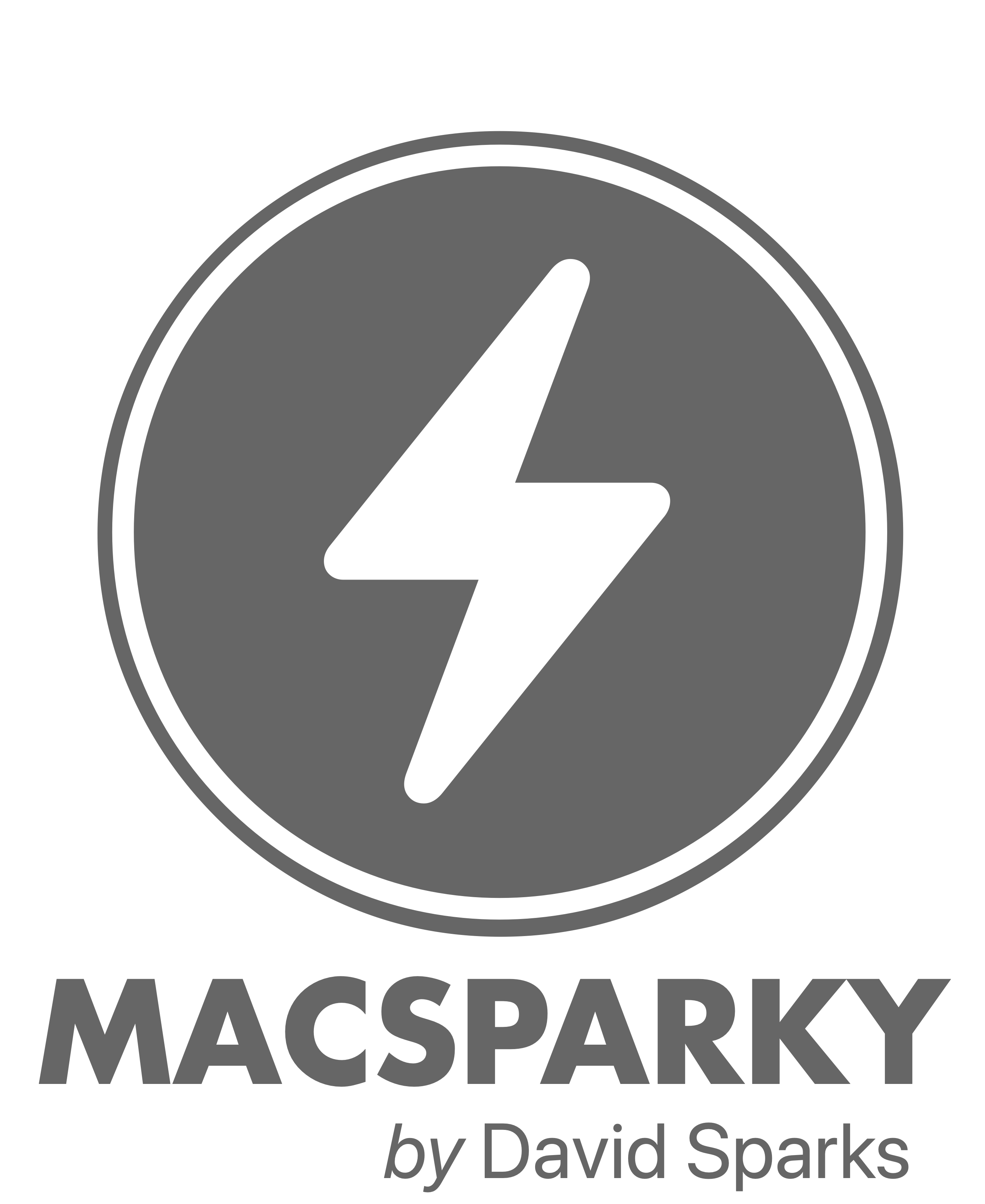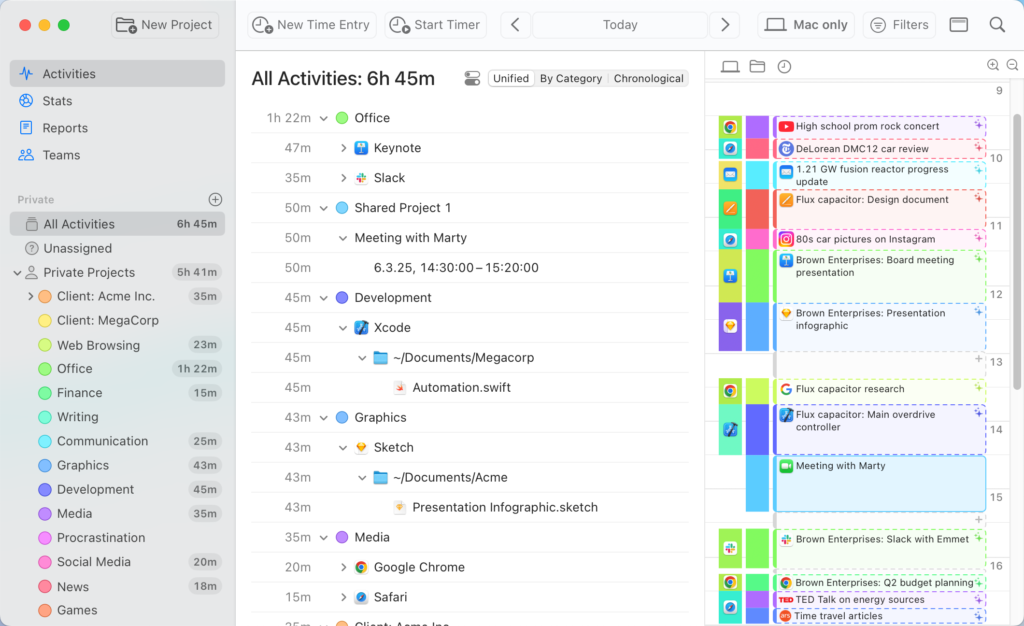In this week’s episode of The Lab Report: Reviews are in for the new MacBook Pro and Mac Studio, more delays on Siri (John Gruber has thoughts) and AI, and Sparky shares a feel-good track from a favorite artist.
… This is a post for MacSparky Labs members only. Care to join? If you’re already a member, you can log in here.
Timing is Your Silent Partner in Productivity (Sponsor)
This week, MacSparky is delighted to feature Timing, the premier automatic time-tracking app for Mac users. Unlike traditional timers that require manual activation, Timing works seamlessly in the background, meticulously recording your activity across apps, websites, and documents. This ensures you gain an accurate and comprehensive overview of how your time is allocated, enabling you to identify productivity patterns and areas for improvement. Looking at your Timing log will let you know exactly what went down if your day ever gets away from you.
Key Features of Timing
- Automatic Tracking: No need to remember to start or stop timers. Timing automatically logs your activities, capturing every detail without manual intervention.
- Detailed Insights: Review precise data on the duration spent on specific applications, documents, or websites. For instance, distinguish between time dedicated to a client proposal in Word versus casual browsing on retail sites.
- AI-Powered Summaries: Leverage artificial intelligence to receive concise summaries of your daily activities, helping you quickly grasp where your time goes without sifting through extensive logs.
- Team Functionality: Timing also has teams support. Collaborate effortlessly by sharing projects, while managers can view aggregated time reports. Importantly, individual privacy is respected, as only manual time entries are visible to supervisors, ensuring a non-intrusive tracking environment.
- Integration and Automation: Timing offers seamless integration with various tools and supports automation through features like Siri Shortcuts and a web API, enhancing your workflow efficiency.
- Web App Access: Access your Timing data from anywhere using the Timing web app. Start and stop timers on the go, manage your team, and integrate with other services, ensuring flexibility and control over your time tracking.
Understanding how you spend your time is the first step toward enhanced productivity. By providing an unobtrusive and precise tracking system, Timing empowers you to make informed decisions about your time.
Focused 225: Tiny Experiments, with Anne-Laure Le Cunff
Anne-Laure Le Cunff joins Mike and me on Focused to talk about the value of tiny experiments and how they enable us to live more focused, intentional lives.
This episode of Focused is sponsored by:
- Squarespace: Save 10% off your first purchase of a website or domain using code FOCUSED.
- Cleft: Capture and Share Notes With Cleft’s AI Scribe.
Apple’s New Child Safety Update: A Step in the Right Direction
Apple recently posted a white paper called Helping Protect Kids Online, where, among other things, they disclosed an upcoming software update that will make it easier to set up child accounts and provide age ranges to developers. I am sure part of the reason for this is pending legislation making platform owners and software developers more responsible for keeping kids out of apps they shouldn’t be in.
The dangers of social media for children are well documented in Jonathan Haidt’s book, The Anxious Generation. Haidt dives deep into how social media has contributed to rising anxiety and mental health struggles among young people. I’d recommend anybody interested in this topic give that book a read.
Social media companies have been doing a lot of finger-pointing at Apple and Google, arguing that platform owners should be responsible for ensuring that children don’t access inappropriate apps. Their claim is that the platform owner is in the best position to determine the age of the user. I’d agree with that.
However, I don’t think platform owners are exclusively responsible for fixing this problem. Indeed, part of me thinks that Facebook had better be careful what it wishes for. If Apple goes through with this update — and I fully expect them to — we will have a reliable age verification system on these devices. That means companies like Meta will have no excuse to claim they didn’t know children were using their applications.
I’m generally very privacy-sensitive, but in this case, I think the trade-off is worth it. Yes, Apple and app developers will know your age range, but at least we’ll have a system in place to help avoid the problems outlined in The Anxious Generation. I’m glad Apple is taking steps in this regard. But this isn’t just Apple’s responsibility. Other participants in this (specifically, social media companies and parents) need to do their part as well.
For parents, this is a good reminder to take an active role in your child’s online experience. With Apple making it easier to set up child accounts and manage access, now is the time to familiarize yourself with these tools. Technology can help, but ultimately, it’s a combination of smart tools and engaged parenting that will make the biggest difference.
Using Supercharge
Sindre Sorhus’ Supercharge is a handy little Mac utility with a pile of little quality-of-life tweaks. Watch this video to learn more.
… This is a post for MacSparky Labs Members. Care to join? Or perhaps you need to sign in?
OpenAI Announces GPT-4.5: A Stepping Stone to GPT-5
The AI march continues. OpenAI has announced that GPT-4.5 is now available for ChatGPT Pro and Enterprise users, with plans to roll it out to lower tiers in the coming weeks.
This new release feels like a stepping stone on the way to GPT-5, which is anticipated to be a significant leap forward but is still a ways off. One of the notable features of GPT-4.5 is enhanced “emotional intelligence.” While that might initially sound like marketing fluff, I’m reserving judgment until I’ve thoroughly tested it. I can say that in testing Anthropic’s Claude, there is an improvement over the ChatGPT 4o model.
Podcast listeners and MacSparky Labs members frequently ask me which AI model they should invest in. Having tested most of the major platforms, at this point, ChatGPT feels like the best all around. It delivers a robust combination of capabilities, making it the most versatile option available at this moment. But this space moves and changes quickly so not promises if that’s still true next week.
That said, I’m particularly curious to see whether GPT-4.5 narrows the gap between ChatGPT and rivals like Claude. I’ll be testing GPT-4.5 over the coming weeks and will report back on how it stacks up against other frontier models.
Mac Power Users 787: Revisiting Our Mac Menu Bars
It’s been a while, so Stephen and I use this episode of Mac Power Users to share what’s in our Macs’ menu bars, touching on some all-time great macOS apps.
This episode of Mac Power Users is sponsored by:
- 1Password: Never forget a password again.
- Ecamm: Powerful live streaming platform for Mac. Get one month free.
- Google Gemini: Supercharge your creativity and productivity.
- Incogni: Take your personal data back with Incogni! Use code MACPOWERUSERS with this link and get 60% off an annual plan.
The Pragmatic Explanation of Apple’s AI-Free iPad
A lot of folks are getting bent out of shape over the fact that the new entry-level iPad, released last week, doesn’t support Apple Intelligence. I don’t really see it that way. The goal of this iPad, in my opinion, is to keep it under $350. Apple sells these things by the thousands to school districts, businesses, and other large-scale purchasers. Adding the additional processor and memory to make Apple Intelligence work could push them past that magic number.

Moreover, I’m not sure these buyers even want artificial intelligence on their devices. Schools, for example, may have concerns about AI privacy and student usage. If you’re buying an iPad for a student, you don’t necessarily want it to help them write their homework. Likewise, corporate IT departments may be wary of AI-related security risks and prefer to keep things simple with a device that doesn’t process AI tasks on-device.
For those who do want Apple Intelligence, every other iPad now supports it, including the newly released iPad Air. The iPad Pro and iPad Air both run on Apple’s M-series chips, which meet the necessary requirements for Apple Intelligence, whereas the base iPad sticks with an A-series chip that lacks the needed processing power and memory.
I do think this may be the last iPad ever released without Apple Intelligence. As Apple refines its AI technology and improves efficiency, I expect that by the time we get to a 12th-generation iPad, it will likely support Apple Intelligence. But for now, I don’t think the lack of it on the new base iPad is as big a deal as people are making it out to be.
Choosing “Send From” Email Account in Apple Mail
If you use multiple email accounts with Apple Mail, here’s a simple trick that takes a minute to set up and will save you time on every damn email you send for the rest of your life.… This is a post for the MacSparky Labs Early Access and Backstage Access members. Care to join? If you’re already a member, you can log in here.
New Apple Hardware
This week, Apple unveiled a bunch of new hardware, including the M4 Mac Studio, M4 MacBook Air, and the latest iPad Air. There’s a lot to discuss:
M4 Mac Studio
Apple’s new Mac Studio has two primary configurations: one with the M4 Max chip and another with the M3 Ultra chip. The M4 Max variant boasts a 16-core CPU and up to 40 GPU cores, delivering substantial performance enhancements over its predecessors. Notably, this model introduces Apple’s latest-generation graphics architecture to the Mac Studio lineup. The base memory has been increased to 36GB, up from the previous 32GB, with options to configure up to 128GB.
The oddball is the M3 Ultra Mac Studio. Because the Ultra (Apple’s top-tier chip) has a longer development cycle, this one is based on M3, not M4. Regardless, it’s a beast. The M3 Ultra configuration offers a 32-core CPU and up to 80 GPU cores. This model starts with 96GB of unified memory, configurable up to a staggering 512GB, making it ideal for tasks such as large-scale AI model training and complex video rendering. This is not a computer for mere mortals.
Both configurations feature Thunderbolt 5 ports. The M4 Max model starts at $1,999, while the M3 Ultra variant begins at $3,999; but you can configure one up to a price north of $14,000. 🙃
Pre-orders are now open, with shipping starting on March 12.
M4 MacBook Air
The MacBook Air lineup has been refreshed with the introduction of M4-powered models, available in both 13-inch and 15-inch screen sizes. This upgrade brings some nice performance improvements, including a 12MP webcam with Center Stage support, enhancing the video conferencing experience. If you’ve wanted a blue Mac, this one’s for you with the new Sky Blue color option. The 13-inch model starts at $999, and the 15-inch model at $1,199. Both models are available for pre-order, with shipping set to begin on March 12.
With this release, I feel Apple has really found its groove for the MacBook Air in the age of Apple silicon. This is a really nice Mac and will be my default recommendation for almost everyone.
iPad Air
Apple has also updated iPad Air, which is now equipped with the M3 chip. This iteration supports advanced accessories, including the new Magic Keyboard and Apple Pencil Pro, further expanding its versatility. The iPad Air starts at $599 for the 11-inch version and $799 for the 13-inch model. Pre-orders are currently open, with availability beginning on March 12. Again, this becomes my default iPad recommendation as it’s a powerful iPad with a great price.
So Apple had a pretty good week and we’ve got some impressive new hardware to consider. Now if only they could get their act together on Siri…But that’s a discussion for another day.




